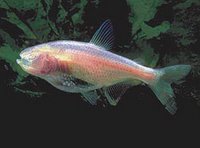 By: Espinasa L, Jeffery WR*
By: Espinasa L, Jeffery WR* Regressive evolution of morphological features is a common evolutionary event. However, the relationship between structural degeneration and loss of physiological function is often unclear because the ancestral and derived states of a character are usually not available for comparison. Here, we report studies on retinomotor rhythms during development of the blind cavefish Astyanax mexicanus, a single teleost species consisting of a sighted surface-dwelling form (surface fish) and several blind cave-dwelling (cavefish) forms. The eyed and blind forms of Astyanax diverged from a common sighted ancestor within the past million years. Despite the absence of functional eyes in cavefish adults, optic primordia are formed in embryos, but then gradually arrest in development, degenerate, and sink into the orbits. Although a layered retina is formed in cavefish embryos, it is deficient in photoreceptor cells, and in some cases the retinal pigment epithelium has lost its pigmentation. We show that the capacity to exhibit light-entrained retinomotor rhythms has been conserved in the degenerating embryonic eyes of two different Astyanax cavefish populations.
The results indicate that loss of circadian retinal function does not precede and is therefore not required for eye degeneration in the blind cavefish.
*Department of Biology, University of Maryland, College Park, MD 20742, USA.
Full article: Evolution & development. 2006 Jan-Feb;8(1):16-22
Photo: Copyright John Brill
Integrated Taxonomic Information System: Astyanax mexicanus
No comments:
Post a Comment